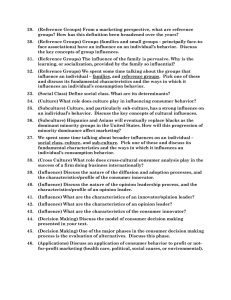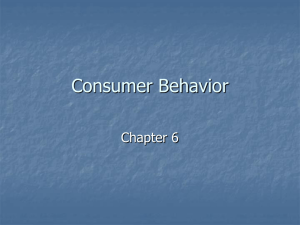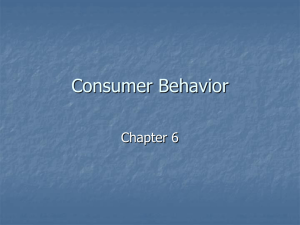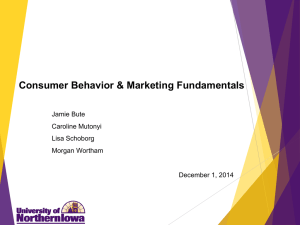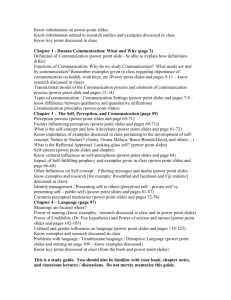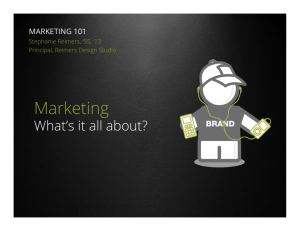advertisement
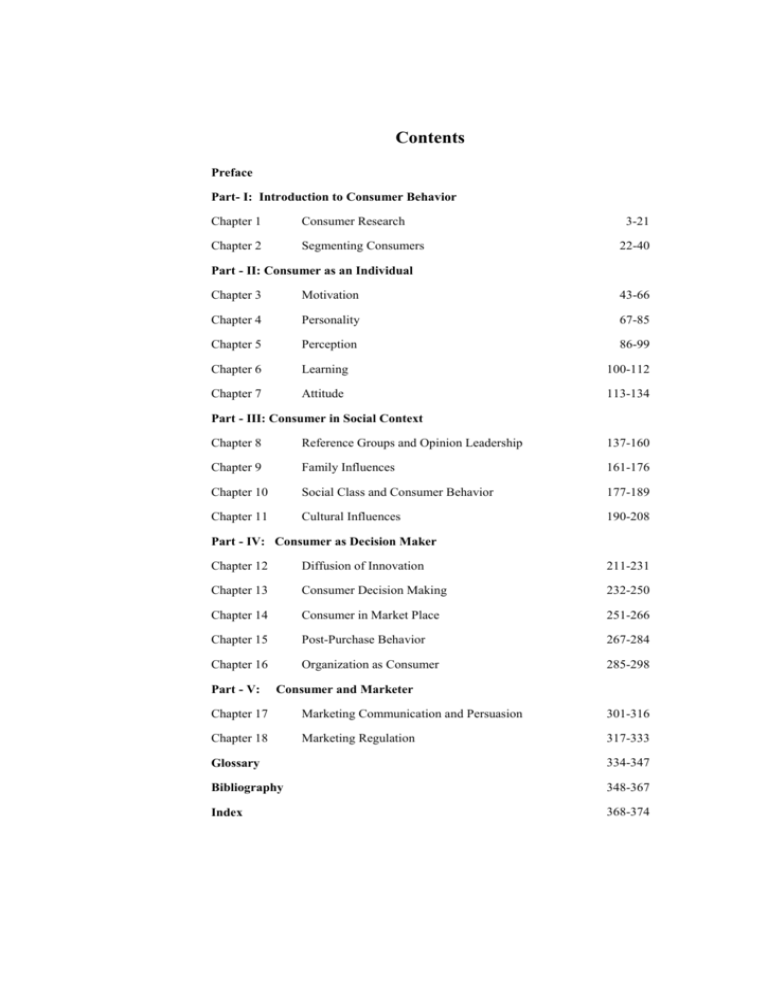
Contents Preface Part- I: Introduction to Consumer Behavior Chapter 1 Consumer Research Chapter 2 Segmenting Consumers 3-21 22-40 Part - II: Consumer as an Individual Chapter 3 Motivation 43-66 Chapter 4 Personality 67-85 Chapter 5 Perception 86-99 Chapter 6 Learning 100-112 Chapter 7 Attitude 113-134 Part - III: Consumer in Social Context Chapter 8 Reference Groups and Opinion Leadership 137-160 Chapter 9 Family Influences 161-176 Chapter 10 Social Class and Consumer Behavior 177-189 Chapter 11 Cultural Influences 190-208 Part - IV: Consumer as Decision Maker Chapter 12 Diffusion of Innovation 211-231 Chapter 13 Consumer Decision Making 232-250 Chapter 14 Consumer in Market Place 251-266 Chapter 15 Post-Purchase Behavior 267-284 Chapter 16 Organization as Consumer 285-298 Part - V: Consumer and Marketer Chapter 17 Marketing Communication and Persuasion 301-316 Chapter 18 Marketing Regulation 317-333 Glossary 334-347 Bibliography 348-367 Index 368-374 Detailed Contents Part I: Introduction to Consumer Behavior Chapter 1:Consumer Research Consumer Research: The Paradigm Shift 5 Quantitative vs. Qualitative 5 Consumer Research Process 6 Defining the Research Problem and Developing Objectives 7 Exploratory Research and Analysis 7 Designing the Conclusive Research 8 Data Collection, Analysis and Findings Report 17 Consumer Research: Good Or Bad? 18 Chapter 2:Segmenting Consumers Defining Market Segmentation 24 Bases for Segmentation 25 Geographic Segmentation 26 Demographic Segmentation 26 Psychological Segmentation 29 Psychographic Segmentation 29 Sociocultural Segmentation 30 Use-related Segmentation 31 Use-situation Segmentation 32 Benefit Segmentation 33 Hybrid Segmentation Approaches 33 Criteria for Effective Targeting of Market Segments 36 Market Segmentation Strategies 38 Concentration Strategy 37 Selective Segmentation Strategy 37 Product Specialization Strategy 37 Market Specialization Strategy 37 Full Market Coverage 37 Counter-segmentation Strategy 38 Part II: Consumer as Individual Chapter 3: Motivation Definition of Motivation 44 The Process of Motivation 45 Dynamic Nature of Motivation 45 Motives 46 Types of Motives 46 Role of Motives in Influencing Behavior 47 Classification of Motives 49 Motives Identified by McGuire 50 Motives identified by Henry Murray 51 Theories of Motivation 52 Maslow’s Theory of Need Hierarchy 53 Trio of Needs 55 Motivational Theory and Marketing Strategies 56 Motivational Research 56 Marketing Strategies Based on Motivation 58 Marketing Strategies Based on Motive Combinations 59 Involvement 59 Antecedents of Involvement 61 Types of Involvement 62 Techniques of Motivational Research 62 Qualitative Research Tools in Motivational Research 63 Chapter 4: Personality Definition of Personality 69 Nature of Personality 69 Personality Reflects Individual Differences 69 Personality is Consistent and Enduring 69 Personality Can Change 69 Theories of Personality 69 Freudian Theory of Personality or Psychoanalytic Theory 70 Application of Freudian Theory in Consumer Behavior 71 Neo-Freudian Theories 74 Trait Theory 77 The Concept of Self 79 Single and Multiple Selves 81 Self and Situational Self 82 Methods of Self-concept Assessment 82 Chapter 5: Perception and Information Processing Definition of Perception 87 Elements of Perception 88 Sensation 88 Absolute Threshold 90 Differential Threshold or Just Noticeable Difference (JND) 90 Subliminal Perception 91 Process of Perception and Information Processing 92 Exposure 93 Attention 94 Interpretation 96 Consumer Imagery 97 Product Image 97 Services Image 98 Perception in Marketing 98 Brand Development and Perceptual Mapping 98 Retail Stores 98 Chapter 6: Learning Defining Learning 101 Characteristics of Learning 101 Motivation 102 Cues 102 Response 102 Reinforcement 103 Behavioral Learning Theories 103 Classical Conditioning 103 Instrumental Conditioning 105 Cognitive Learning Theories 106 Information Processing 106 Theory of Involvement 107 Brand Loyalty 109 Brand Equity 109 Product Positioning 109 Brand Leverage 110 Chapter 7: Attitudes and Consumer Behavior Characteristics of Attitudes 114 Functional Theory of Attitudes 116 Utilitarian Function 117 Value-expressive Function 118 Ego-defense Function 118 Knowledge Function 118 Combination of Functions 119 Attitude Models 119 Tri-component Model 119 Shortcomings of Tri-component Model 120 Consistency of Components 121 Multi-attribute Model of Attitudes 121 Theory of Trying to Consume 124 Attitude toward the Ad Model 126 Formation of Attitudes 126 Classical Conditioning 126 Instrumental Conditioning 126 Cognitive Learning Theory 126 Measurement of Attitudes 127 Semantic Differential Scale 128 Likert Scale 128 Theories of Attitude Development 128 Theory of Cognitive Dissonance 128 Self-Perception Theory 129 Social judgment Theory 130 Balance Theory 130 Attitude Change 131 Changing the Function that the Product Serves 132 Associate the Product with a Famous Personality or an Established Organization 132 Changing Attitudes by Presenting the Product in a New Light 132 Change the Beliefs of the Consumer Regarding the Product 132 Try to Change the Perception of the Consumer 132 Involvement 133 Strategies followed by Marketers to Increase the Involvement of Consumers 133 Part III: Consumers in Social Context Chapter 8: Reference Groups and Opinion Leadership Defining Reference Groups 138 Reference Group Influence 139 Reference Groups and Conformity 142 Important Reference Groups and Appeals 142 Friends 142 Shopping Group 142 Work Groups 143 Virtual Communities 143 Brand Communities 143 Consumer-Action Groups 143 Celebrities 144 The Expert 145 The Common Man 146 The Executive and Employee Spokesperson 147 Spokes-Characters 148 Other Reference Group Appeals 148 Defining Opinion Leadership 148 Dynamics of Opinion Leadership 149 The Motivation behind Opinion Leadership 150 Types of Opinion Leaders 150 Identifying an Opinion Leader 153 Self-Designating Method 153 Sociometric Method 154 Key Informant Method 154 Objective Method 154 Communication and Opinion Leadership 154 Creating Buzz 155 Chapter 9: Family Influences Defining Family 160 Types of Family Structures 163 Nontraditional Households 163 Pets as Family Members 164 Role of Family 164 Family Lifecycle 167 Traditional FLC 168 Non-Traditional FLC 170 Family Decision Making 171 Household Decisions 171 Sex Role and Decision-Making 172 Children as Decision Makers 173 Chapter 10: Social Class and Consumer Behavior Defining Income 178 Defining Social Class 178 Social Stratification 179 Social Classes in India 180 Social Class Mobility 180 Social Class Measurement 181 Subjective Approach 181 Reputational Approach 181 Objective Approach 181 Problems with Measurement of Social Class 183 Geodemographic Clustering 183 Social Class and Consumer Behavior 184 Cultural Capital 184 The Affluent Consumer 184 Old Money and the Nouveaux Riche 186 Techno Class 187 Status Symbol 187 Chapter 11: Cultural Influences Defining Culture 191 The Dynamics of Culture 192 Measuring Culture 197 Content Analysis 197 Consumer Fieldwork 197 Value Measurement Survey Instruments 197 Core Values 198 Defining Sub-Culture 198 Defining Cross-Cultural Influences 201 Country-of-origin Effects 202 Targeting Consumers across Cultures 203 Global versus Local 203 Cross-Cultural Marketing Mistakes 204 Part IV: Consumer as Decision Maker Chapter 12:Diffusion of Innovation The Diffusion Concept 212 Innovation 213 Channels of Communication 219 Social System 219 Time 221 A Profile of Consumer Innovator 227 Innovator as an Opinion Leader and Change Leader 228 Chapter 13: Consumer Decision-making Defining Consumer Decisions 233 Consumers as Decision Makers 234 Types of Consumer Decisions 234 Consumer Decision-Making Process 236 Problem Recognition 237 Information Search 240 Alternative Evaluation and Selection 243 Modeling Consumer Decision-Making 246 Howard-Sheth Model of Buying Behavior 246 The Nicosia Model 247 Engel-Blackwell-Miniard Model 247 Chapter 14: Consumer in Marketplace Introduction to Retailing 252 The Retail Scene in India 252 Unconventional Sources of Purchase 252 Factors Affecting Outlet Selection 256 Store Image 256 Store Brands 256 Retail Advertising and Promotions 257 Store Location 258 Perceived Risk 259 Shopping Orientation 260 In-Store Influences 261 In-store Displays 262 Markdowns and Price-promotions 263 Store Atmosphere 263 Stock-outs 263 Sales Staff 263 Final Transaction 264 Chapter 15: Post-Purchase Behavior Defining Post-Purchase Consumer Behavior 268 Consumer’s Post-Purchase Dissonance 268 Product Usage 271 Disposal 272 Product/Service Evaluation And Consumer Satisfaction/ Dissatisfaction 276 Consumer Complaint Behavior 278 Satisfaction and Brand Loyalty 279 Loyalty Marketing 280 Chapter 16:Organizations as Consumers Nature of Organizational Buying 286 Organization’s Business Center 287 Organizations’ Buying Situations 289 Organizational Buying Process 290 Problem Recognition 290 Need Description 291 Product Specification 291 Supplier Search and Evaluation 291 Proposal Solicitation 291 Supplier Selection 291 Order and Post-Purchase Evaluation 292 Factors Influencing Organizational Buying Behavior 293 Internal Factors 293 External Factors 293 Segmenting Business Markets 295 Part V: Consumer and Marketer Chapter 17: Marketing Communication and Persuasion Nature of Communication 302 Elements of Communication 302 Factors Affecting Communication 304 Credibility of the Source 304 Comprehension and Mood of the Receiver 305 Barriers to Communication 305 Developing Persuasive Communication 306 The Target Audience 306 The Objective 306 The Message Design 307 The Media 313 Chapter 18: Market Regulation Concerns of the Consumers 319 Consumerism 319 Privacy Concerns 319 Impact of Advertising 321 Social Marketing 324 Marketing to Children 325 Concerns of the Marketers 327 Consumer Fraud 327 Consumer Terrorism 327 Anti-consumption 328 The Role of Government and Non-Government Bodies 328 Government Regulations 328 The Advertising Standards Council of India 329 Consumer Action Groups 329
